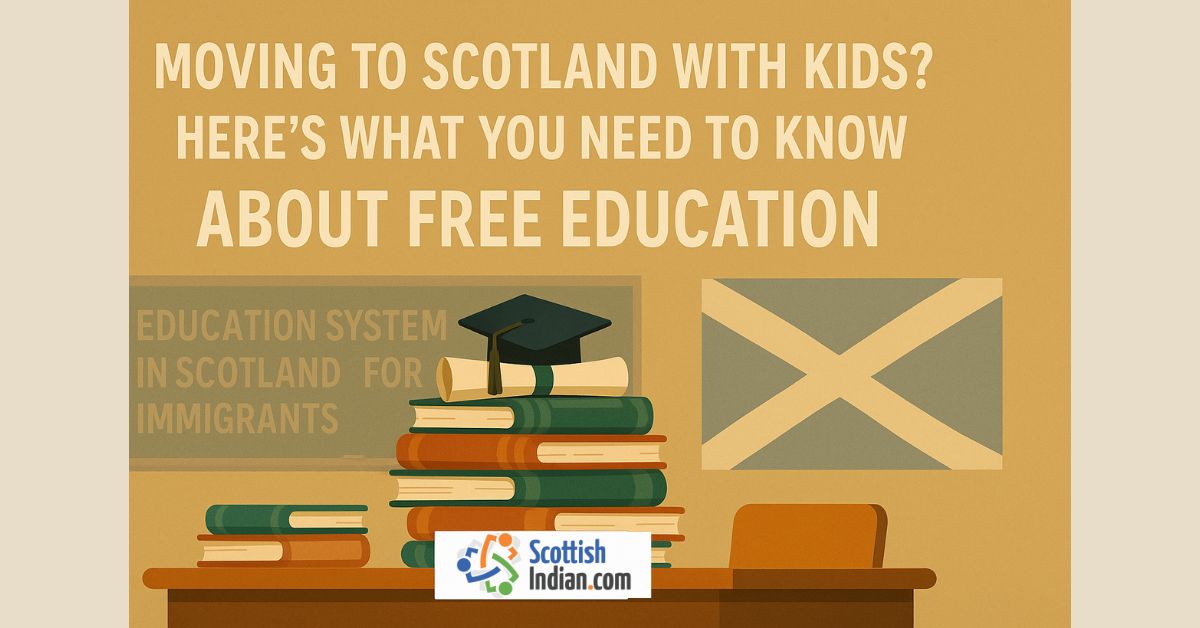When families move to the UK, one of the biggest concerns is how the local school system works and what it will cost. Scotland stands out because it offers one of the fairest and most accessible public education systems in Europe. The education system in Scotland for immigrants is designed to ensure that every child who legally lives in the country has access to safe, high quality, and publicly funded education. This includes NRI families, international workers, and new migrants who are still adjusting to life in the UK.
This detailed guide explains everything parents need to know about schooling, free nursery hours, support systems, curriculum structure, and the truth behind Scotland’s famous “free university education”. Parents who are new to the country can also explore our guide on settling in the UK.
1. Understanding the Scottish Education Structure
Scotland runs its own education system. It is separate from England, Wales, and Northern Ireland. It follows the Curriculum for Excellence (CfE), which aims to develop children who are:
- Successful learners
- Confident individuals
- Responsible citizens
- Effective contributors
Here is a complete breakdown of the stages.
Early Learning and Childcare (Ages 3–5)
Children aged 3 and 4, and some eligible 2 year olds, receive up to 1,140 hours of funded early learning each year for childcare. This includes:
- Public nurseries
- Approved private nurseries
- Childminders registered with the council
Funded hours apply to most immigrant families with valid visas. Parents only need to prove Scottish residency.
What you may still pay for
- Meals
- Extra hours beyond the funded 1,140 hours
- Special activities like trips
For many families, nursery is nearly cost free compared to England where childcare is far more expensive.
Primary School (P1–P7, Ages 5–12)
Primary education is entirely free. This includes:
- Tuition
- Books and learning materials
- Access to school libraries
- Basic stationery
- Learning support
Children study seven broad areas.
- Languages
- Mathematics
- Health and wellbeing
- Sciences
- Social studies
- Technologies
- Expressive arts
Additional support for immigrant children
If your child is still learning English, they will receive EAL support (English as an Additional Language). Teachers are trained to help children who join mid year or mid stage.
Our education and family guides often cover topics like childcare, community culture and practical parenting in Scotland.
Secondary School (S1–S6, Ages 12–18)
Secondary education is free for all legal residents. Students work toward qualifications such as:
- National 3, 4, 5
- Highers (usually required for university entry)
- Advanced Highers (equivalent to first year of university)
- Vocational awards through colleges
Why this matters for NRI families
Scotland offers multiple pathways. Your child does not have to follow just one academic route. Many Indian parents appreciate that:
- Highers are flexible.
- Students can take fewer subjects but study them deeply.
- Students can enter college, then transfer to university later.
This flexibility suits children who are adjusting to a new country, climate, and education culture.
2. Who Can Access Free Education in Scotland?
The rule is simple. If you live legally in Scotland, your child can attend school for free. This includes:
- Skilled Worker visa families
- Health care professionals on sponsored visas
- Postgraduate students with dependants
- Dependants of work visa holders
- Pre settled and settled status families
- International workers relocating from Europe, Asia, Africa, or the Middle East
You do not need a British passport and you do not need permanent residency for school access.
Families adjusting to the system will find our updates useful.
You will only need to provide:
- Proof of address
- Proof of immigration status
- Child’s passport and birth certificate
- Immunisation records
Councils in Scotland are known for being supportive and friendly to immigrant families during enrolment.
3. The Reality Behind “Free University Education” in Scotland
Many families on social media hear that university in Scotland is free. This is half true and half misunderstood.
Here is the accurate explanation.
Who actually studies for free?
Free university tuition is available to:
- Students who are residents of Scotland
- Students from the EU who meet residency requirements
- Refugees and some protected groups
These students receive funding from SAAS (Student Awards Agency Scotland).
Do immigrant children qualify?
Yes, but not immediately. To qualify for free tuition, your child must usually:
- Live in Scotland for a set period before the course begins
- Hold a visa that allows them to stay long term
- Not be considered an international student
Most NRI families will need to wait until they are long term residents. Children who grow up in Scotland almost always qualify by the time they reach university age.
Who pays international student fees?
You will pay full international tuition if:
- You moved to Scotland recently
- You hold a temporary visa
- You do not meet SAAS residency requirements
International fees can range from £14,000 to £30,000 per year depending on the degree.
4. Additional Benefits for Immigrant and NRI Parents
Scotland offers several advantages that many families do not expect.
Free School Meals and Financial Support
Many primary schools offer:
- Free school meals for P1 to P5
- Clothing grants for low income families
- Free transport if the school is far from home
Scotland’s model supports vulnerable families regardless of nationality.
Specialised English Support
Teachers are trained to support:
- Children who recently arrived
- Children who speak more than one language
- Children struggling with communication
Schools also hire multilingual support workers.
Mental Health and Wellbeing Support
Scotland places heavy importance on wellbeing. Schools have:
- Counsellors
- Mental health leads
- Anti bullying programs
- Peer support groups
This is often appreciated by families relocating from high pressure education systems.
College Pathways for New Arrivals
Scottish colleges offer flexible entry points for teenagers who arrive mid way through their education. This includes:
- ESOL courses
- Vocational diplomas
- Bridge courses that lead into university
This ensures no child’s education is interrupted by immigration timelines.
5. How to Enrol Your Child in a Scottish School
Here is a step by step guide.
- Check your local council website.
- Find your catchment school based on your address.
- Contact the school office.
- Submit documents.
- Arrange a school visit.
- Agree on a start date.
Scottish councils rarely reject applications for catchment schools.
Moving countries is overwhelming for any family however Scotland’s education system is built to welcome immigrants and support children at every stage. The education system in Scotland for immigrants provides stability, flexibility, and inclusiveness. From nearly free nursery hours to publicly funded schooling and the possibility of free university tuition later, Scotland offers one of the best environments for children to grow, learn, and thrive.






